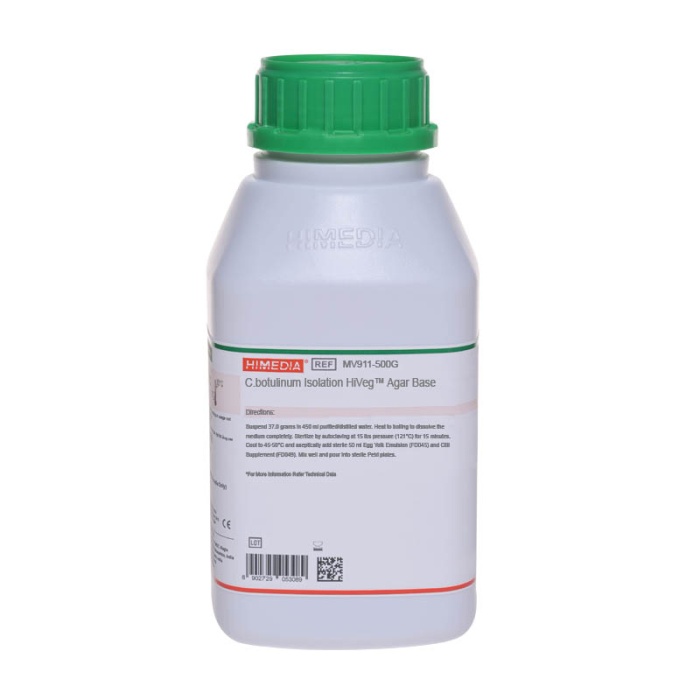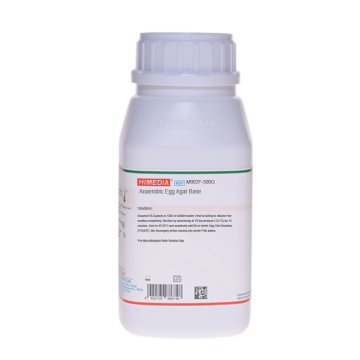 Your enquiry has been submitted
Your enquiry has been submitted
LV Agar Base, Modified (Liver-Veal-Agar Base, Modified)
Intended Use
Recommended for isolation of Clostridium botulinum in accordance with FDA BAM, 1998.
Composition**
| Ingredients | g / L |
|---|---|
| HL infusion from 50 g # | 1.400 |
| HMV infusion from $ | 14.000 |
| Proteose peptone | 20.000 |
| Peptone special | 1.300 |
| Tryptone | 1.300 |
| Dextrose (Glucose) | 5.000 |
| Starch soluble | 10.000 |
| Sodium chloride | 5.000 |
| M-Protein, purified | 2.000 |
| Sodium nitrate | 2.000 |
| Gelatin | 20.000 |
| Agar | 15.000 |
Final pH ( at 25°C): 7.3±0.2
**Formula adjusted, standardized to suit performance parameters
$ - Equivalent to Veal, infusion from
#- Equivalent to Liver infusion from
Directions
Suspend 97 grams in 1000 ml warm purified / distilled water. Heat to boiling to dissolve the medium completely, and sterilize at 15 lbs (121ºC) for 15min. Cool to 45-50 ºC. Aseptically add 80 ml Egg yolk emulsion,50% (FD045F). Mix well and pour into sterile Petri dishes.
Principle And Interpretation
Anaerobic bacteria live in an oxygen-free environment. Some of the anaerobic bacteria die in presence of oxygen while others fail to grow and multiply (1). Liver Veal Agar Base, Modified (M1872) is a modification of the medium formulated by Spray, 1936 (2). It is recommended by the FDA Bacteriological Analytical Manual (BAM) (3) for the growth of anaerobic organisms especially Clostridium botulinum. This may also be used in supplementation with 50% egg yolk (FD045F) (3,4). Clostridium botulinum is an anaerobic, rod-shaped spore forming bacterium that produces a protein with characteristic neurotoxicity. Under certain conditions, these organisms may grow in foods producing highly dangerous botulinum toxin(s). Botulinum toxin has been classified into botulinum A, botulinum B upto G. Among this all except F and G are known to cause animal botulism. Different strains are classified through antigenic characterization using appropriate antitoxins. They are also differentiated into general groups on the basis of cultural, biochemical, and physiological characteristics.
Both the infusions: HL infusion from and HMV infusion from, other peptones and gelatin serve as sources of carbon, nitrogen, amino acids and various vitamins. Dextrose serves as the energy source. Starch enhances growth of anaerobic bacteria. Sodium chloride maintains the osmotic equilibrium of the medium. Agar acts as the solidifying agent.
According to the FDA BAM protocol, suspected samples after preliminary examination is proceeded for enrichment of the organism. 1-2 g or 1-2 ml of samples after removing the dissolved oxygen content are inoculated into Cooked meat medium (M149) and Tryptone Peptone Glucose Yeast Extract Broth Base w/o Trypsin (M969) and incubated at 35°C and 25°C respectively. Upon 5 days of incubation, growth is checked by turbidity, gas production, and digestion of meat particles and different staining procedures of the growth. For isolation of pure cultures, alcohol pretreated samples are inoculated into Liver-Veal-Agar Base, Modified (M1872) and/ or Anaerobic Egg Agar Base (M902F). The luster zones of different types vary often including variation in yellow precipitates. Serological, biochemical and in vivo assays are performed to confirm the serotypes.
Type of specimen
Food and dairy samples.
Specimen Collection and Handling
For food and dairy samples, follow appropriate techniques for sample collection and processing as per guidelines (5,6,7). After use, contaminated materials must be sterilized by autoclaving before discarding.
Warning and Precautions
Read the label before opening the container. Wear protective gloves/protective clothing/eye protection/ face protection. Follow good microbiological lab practices while handling specimens and culture. Standard precautions as per established guidelines should be followed while handling specimens. Safety guidelines may be referred in individual safety data sheets.
Limitations
- Further biochemical and serological tests must be carried out for further identification.
Performance and Evaluation
Performance of the medium is expected when used as per the direction on the label within the expiry period when stored at recommended temperature.
Quality Control
Appearance: Light yellow to brownish yellow homogeneous free flowing powder
Gelling: Firm,comparable with 1.5% Agar gel
Colour and Clarity of prepared medium: Amber coloured clear to slightly opalescent gel forms in Petri plates, may have slight precipitate.
Reaction: Reaction of 9.7% w/v aqueous solution at 25°C. pH : 7.3±0.2
pH: 7.10-7.50
Cultural Response
Cultural characteristics observed after an incubation at 35-37°C for 18-24 hours with addition of Egg yolk emulsion(under the atmospheric requirement of organism).
| Organism | Growth |
|---|---|
| Clostridium botulinum ATCC 25763 | luxuriant |
| Clostridium tetani ATCC 10709 | luxuriant |
| Streptococcus pneumoniae ATCC 6303 | luxuriant |
Storage and Shelf Life
Store between 10-30°C in a tightly closed container and the prepared medium at 20-30°C. Use before expiry date on the label. On opening, product should be properly stored dry, after tightly capping the bottle in order to prevent lump formation due to the hygroscopic nature of the product. Improper storage of the product may lead to lump formation. Store in dry ventilated area protected from extremes of temperature and sources of ignition. Seal the container tightly after use. Product performance is best if used within stated expiry period.
Disposal
User must ensure safe disposal by autoclaving and/or incineration of used or unusable preparations of this product. Follow established laboratory procedures in disposing of infectious materials and material that comes into contact with sample must be decontaminated and disposed of in accordance with current laboratory techniques (8,9).
Reference
- Alcamo, I. E. 2001 Fundamentals of Microbiology 6 ed.: Jones and Bartlett Publishers.
- Spray, R. S. 1936. J. Bacteriol, 32(135).
- FDA, U.S. 1998. Bacteriological Analytical Manual. 8 ed. Gaithersburg, Md. : AOAC International.
- APHA. 2001. Compendium of Methods for the Microbiological Examination of Foods.F. P Downes and Ito K Ed. Washington, D.C.
- American Public Health Association, Standard Methods for the Examination of Dairy Products, 1978, 14th Ed., Washington D.C.
- Salfinger Y., and Tortorello M.L. Fifth (Ed.), 2015, Compendium of Methods for the Microbiological Examination of Foods, 5th Ed., American Public Health Association, Washington, D.C.
- Wehr H. M. and Frank J. H., 2004, Standard Methods for the Microbiological Examination of Dairy Products, 17th Ed., APHA Inc., Washington, D.C.
- Isenberg, H.D. Clinical Microbiology Procedures Handbook. 2nd Edition.
- Jorgensen, J.H., Pfaller, M.A., Carroll, K.C., Funke, G., Landry, M.L., Richter, S.S and Warnock., D.W. (2015) Manual of Clinical Microbiology, 11th Edition. Vol. 1.
| Product Name | LV Agar Base, Modified (Liver-Veal-Agar Base, Modified) |
|---|---|
| SKU | M1872 |
| Product Type | Regular |
| Physical Form | Powder |
| Origin | Animal |
| Packaging type | HDPE |
| References | 1.Alcamo, I. E. 2001 Fundamentals of Microbiology 6 ed.: Jones and Bartlett Publishers.2.Spray, R. S. 193 |
| Customized Product Available | No |









